This is a great presentation from South Park creators Matt Stone and Trey Parker on plotting using the key words “but” and “therefore.” It’s brilliant. Watch it.
This is a great presentation from South Park creators Matt Stone and Trey Parker on plotting using the key words “but” and “therefore.” It’s brilliant. Watch it.
While the Nerdist Industries’ arena event at WonderCon this year was ostensibly about the future of the Youtube based pop culture conglomerate, and, indeed, plenty was said about upcoming projects, the question and answer period really expanded into a call to arms for fans to help directly determine the future of pop culture.
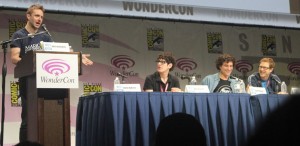 Nerdist founder Chris Hardwick took the stage, joined by panellists Paul Provenza, Troy Conrad, and Matt Bennett, on March 31st, in the lead up to the season finale of The Walking Dead. Hardwick’s job as host of Talking Dead meant there was plenty of frisson in the audience about the upcoming show, and Hardwick teased, but didn’t deliver, spoilers on the show’s finale several times. In fact, he informed the audience that he was about to “get into a car to film Talking Dead” following his WonderCon appearance. Envy at his early viewing of the finale was palpable.
Nerdist founder Chris Hardwick took the stage, joined by panellists Paul Provenza, Troy Conrad, and Matt Bennett, on March 31st, in the lead up to the season finale of The Walking Dead. Hardwick’s job as host of Talking Dead meant there was plenty of frisson in the audience about the upcoming show, and Hardwick teased, but didn’t deliver, spoilers on the show’s finale several times. In fact, he informed the audience that he was about to “get into a car to film Talking Dead” following his WonderCon appearance. Envy at his early viewing of the finale was palpable.
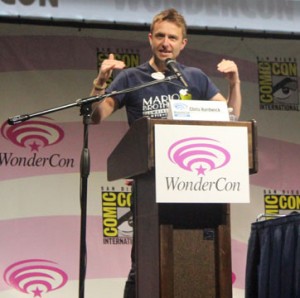 While Hardwick has a cult following as host of Talking Dead, and also from plenty of Nerdist projects, his presence live is even more dynamic, bringing with it plenty of his stand up comedy background. Since it was also Easter Sunday, Hardwick opened with a relevant quip: “That’s one person who came back from the dead and didn’t do it to rip someone’s heart out. Just put the love in it”. About a thousand attendees found this hilarious. Hardwick showed a promo video preview of upcoming Nerdist projects, often punctuated by applause and cheers from the audience when they recognized an anticipated segment or a celebrity guest coming up on a project, and followed by discussing several of the projects in a little more detail with his panellists.
While Hardwick has a cult following as host of Talking Dead, and also from plenty of Nerdist projects, his presence live is even more dynamic, bringing with it plenty of his stand up comedy background. Since it was also Easter Sunday, Hardwick opened with a relevant quip: “That’s one person who came back from the dead and didn’t do it to rip someone’s heart out. Just put the love in it”. About a thousand attendees found this hilarious. Hardwick showed a promo video preview of upcoming Nerdist projects, often punctuated by applause and cheers from the audience when they recognized an anticipated segment or a celebrity guest coming up on a project, and followed by discussing several of the projects in a little more detail with his panellists.
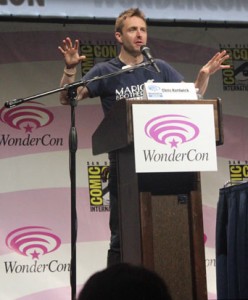 Bennet’s new series, currently being filmed, entitled Nerdy Jobs, a play on Dirty Jobs, got particular attention. The series will involve him visiting nerdy “cool” companies like tech industries and comic book shops to give an insider’s view of working there. Hardwick pondered what Bennett would find to say if he visited NASA for the show: “Uh, sorry about your funding?”. Another big push for Nerdist is the launch of a comedy combination of stand up and improv based on the British series concept Setlist, a competition that will tour around the world. As a veteran of stand up, Hardwick was particularly enthused, commenting that forcing stand up comedians into an improv situation is like “looking for the God particle of comedy”. His request to the audience about the upcoming new shows: “Please don’t feel compelled to say horrible things IN ALL CAPS in comment threads”.
Bennet’s new series, currently being filmed, entitled Nerdy Jobs, a play on Dirty Jobs, got particular attention. The series will involve him visiting nerdy “cool” companies like tech industries and comic book shops to give an insider’s view of working there. Hardwick pondered what Bennett would find to say if he visited NASA for the show: “Uh, sorry about your funding?”. Another big push for Nerdist is the launch of a comedy combination of stand up and improv based on the British series concept Setlist, a competition that will tour around the world. As a veteran of stand up, Hardwick was particularly enthused, commenting that forcing stand up comedians into an improv situation is like “looking for the God particle of comedy”. His request to the audience about the upcoming new shows: “Please don’t feel compelled to say horrible things IN ALL CAPS in comment threads”.
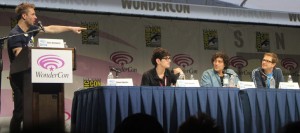 This led Harwick to speak for a moment about Youtube as a venue for hosting programming. Though delivered in a comically serious tone, the message had some bite: “No longer do companies tell us what to watch”. It was the first of several comments that indicated that Hardwick still has a lot to say about the role of open access and its giant-killing capabilities in relation to big media. Nerdist Industries, he said, is going to be expanding, but not along the lines of some of their peers on Youtube, who branch out into “piles of channels”; instead, they are aiming for a “hyper-curated partnership” with 6-8 channels and plenty of intensive “cross promotion”. They are also considering a move, based on fan request, to try out video podcasts, though Hardwick is a little skeptical of why people would want to watch them. Demand has been high enough that he’s prepared to yield to the experiment. Upcoming guests for the video podcast will include Seth Rogan, Steve Young, Scott Adsit and “surprises” too. Nerdist will also, finally, launch a major app to link to its content and, even more surprisingly, will be venturing into filmmaking following their purchase by Legendary Entertainment. They hope to work as producers on smaller budget films in this new role.
This led Harwick to speak for a moment about Youtube as a venue for hosting programming. Though delivered in a comically serious tone, the message had some bite: “No longer do companies tell us what to watch”. It was the first of several comments that indicated that Hardwick still has a lot to say about the role of open access and its giant-killing capabilities in relation to big media. Nerdist Industries, he said, is going to be expanding, but not along the lines of some of their peers on Youtube, who branch out into “piles of channels”; instead, they are aiming for a “hyper-curated partnership” with 6-8 channels and plenty of intensive “cross promotion”. They are also considering a move, based on fan request, to try out video podcasts, though Hardwick is a little skeptical of why people would want to watch them. Demand has been high enough that he’s prepared to yield to the experiment. Upcoming guests for the video podcast will include Seth Rogan, Steve Young, Scott Adsit and “surprises” too. Nerdist will also, finally, launch a major app to link to its content and, even more surprisingly, will be venturing into filmmaking following their purchase by Legendary Entertainment. They hope to work as producers on smaller budget films in this new role.
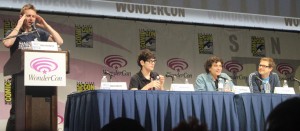 While Hardwick was delivering his energetic spiel, Provenza interjected, “Do you ever sleep?”. It was true, Hardwick looked a little peaked. “I have a robot heart”, he intoned, and continued on to the question and answer period. Questions began with a repeat offender from SDCC who Hardwick had once hugged in the past for his super fandom regarding Superman. “Comic Con is about getting super freaked out about stuff you love”, Hardwick reminded the audience (and he would deliver another hug later to a girl dressed as Wario in sympathy with his own Mario Brothers t-shirt). Harwick was then asked what he would do if his girlfriend was found to be “patient zero” in a potential zombie apocalypse. “Oh, I’d shoot her in the fucking head. That’s what you do for your loved ones”, he said without hesitation, to much hilarity, and added that he hoped she’d do the same for him.
While Hardwick was delivering his energetic spiel, Provenza interjected, “Do you ever sleep?”. It was true, Hardwick looked a little peaked. “I have a robot heart”, he intoned, and continued on to the question and answer period. Questions began with a repeat offender from SDCC who Hardwick had once hugged in the past for his super fandom regarding Superman. “Comic Con is about getting super freaked out about stuff you love”, Hardwick reminded the audience (and he would deliver another hug later to a girl dressed as Wario in sympathy with his own Mario Brothers t-shirt). Harwick was then asked what he would do if his girlfriend was found to be “patient zero” in a potential zombie apocalypse. “Oh, I’d shoot her in the fucking head. That’s what you do for your loved ones”, he said without hesitation, to much hilarity, and added that he hoped she’d do the same for him.
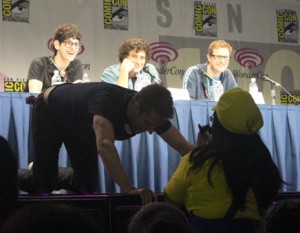 He seemed pretty serious about that topic, but not as serious as he became immediately after the question on the subject of open access production. “There is literally no excuse for you not to pursue things that you love now. You are living half a life if you do not pursue the things that you love”, he said, referring to the tools now available for fans and pop culture creators alike. When a middle school teacher asked him for ideas to keep her students interested in pop culture in their newly formed lunch club, he gave a very invested answer, repeating that the most important thing the teacher could do for them would be to get them to “make things”, whether videos, or other media. “Teach them to be creators vs. consumers”, he pleaded, to much approbation from the crowd.
He seemed pretty serious about that topic, but not as serious as he became immediately after the question on the subject of open access production. “There is literally no excuse for you not to pursue things that you love now. You are living half a life if you do not pursue the things that you love”, he said, referring to the tools now available for fans and pop culture creators alike. When a middle school teacher asked him for ideas to keep her students interested in pop culture in their newly formed lunch club, he gave a very invested answer, repeating that the most important thing the teacher could do for them would be to get them to “make things”, whether videos, or other media. “Teach them to be creators vs. consumers”, he pleaded, to much approbation from the crowd.
 One of Hardwick’s winning qualities that keeps him from drifting too far from his fanbase due to his ever increasing media success is his earnestness, often placing himself in the role of the fan once more. He described himself as a “lamprey” feeding off the “giant sperm whale” of pop culture products and feeling grateful, trying not to “impose” when working with actors from major shows. The Nerdist panel emphasized again that Hardwick still sees himself as an outsider in the mainstream, and an insider to “nerd” culture, no matter how many celebrity friends he accrues. That lends credence to his requests and his advice that fans continue to interact directly with the things they love through becoming “creators” too.
One of Hardwick’s winning qualities that keeps him from drifting too far from his fanbase due to his ever increasing media success is his earnestness, often placing himself in the role of the fan once more. He described himself as a “lamprey” feeding off the “giant sperm whale” of pop culture products and feeling grateful, trying not to “impose” when working with actors from major shows. The Nerdist panel emphasized again that Hardwick still sees himself as an outsider in the mainstream, and an insider to “nerd” culture, no matter how many celebrity friends he accrues. That lends credence to his requests and his advice that fans continue to interact directly with the things they love through becoming “creators” too.
Photo Credits: All photos in this article were taken by semi-professional photographer and pop culture scholar Michele Brittany. She’s an avid photographer of pop culture events. You can learn more about her photography and pop culture scholarship here.
Hannah Means-Shannon writes and blogs about comics for TRIP CITY and Sequart.org and is currently working on books about Neil Gaiman and Alan Moore for Sequart. She is @hannahmenzies on Twitter and hannahmenziesblog on WordPress.
Later this year IDW will be publishing Half Past Danger, a new series written, drawn, and created by Stephen Mooney. After working as artist on several IDW titles including Star Trek and Angel for the last few years, Mooney decided it was time to set up a creator-owned project, which he’d have full control over. In order to do so, he had to set aside a year in which he scripted, designed, pencilled, inked, coloured and lettered the project – six months in which he wasn’t earning money from any other gigs. It was quite the risk, taking himself out of the comics scene for a year in order to focus on a comic he had no idea would ever see the light of day.
However! The good news is that IDW decided to pick up the book, starting with issue #1 this May – preorderable now! I spoke to Stephen about making the leap into creator-owned work, the inspiration for Half Past Danger, and how the experience has been.
Steve: Half Past Danger is dedicated to your father, “who took me to the movies”. What kind of films would you go see? Were there any in particular which served as inspiration for Half Past Danger?
Stephen: Oh wow, yeah. Loads! The first film I can remember my dad taking my brothers and I to see was E.T. in the Savoy cinema in Dublin in 1982, when I was five years old. Still my favourite cinema to this day. I can remember it like it was yesterday; its one of my first real memories. The whole experience made such a huge indelible dent on my psyche, in so many ways. The bustling anticipatory atmosphere of the jam-packed theatre, the crowd reactions as the movie ebbed and lowed. I was absolutely hooked. It also started my love affair with Spielberg’s eighties ouevre. Films that followed included The Return of The Jedi, Indiana Jones and the Temple of Doom, The Goonies, Back To The Future, Big Trouble In Little China, Indiana Jones and The Last Crusade, and many, many more.
The most obvious influences on Half Past Danger filmically-speaking are undoubtedly the first three Indiana Jones movies. They really colour and inform my entire storytelling style. That bang-zip-wallop rapid-fire action beats-ridden kind of a narrative, with a few gags interspersed. Half Past Danger aspires to be that style of tale. Strong influences also would be the very early Connery Bond films, and pulpy matinee-style fare like The Treasure of the Sierra Madre. Then of course you have the classic Harryhausen dino movies. Great stuff, all.
Steve: How did the story of Half Past Danger start to come together? When did you first have the idea for it?
Stephen: The idea has been in my mind in some shape or form for years now, in that I’ve always known that if and when I ever attempted a story of my own that it would be 100% mired in that kind of pulpy action-adventure style, simply because that’s the genre I feel most comfortable in, and know so well. I always knew also that I’d want the main character to be an Irishman, since that’s the one thing I’ve been all my life, and nobody could tell the story of that particular character better than me, to my mind. I guess somewhat inevitably I injected much of my own personality and traits into a somewhat idealised version of myself, and placed him squarely into this scenario I’d begun to dream up. Hell, the guy even looks like me. If that’s not vanity wit large, I dunno what is.
The story came together over the last couple of years, I knew the high concept from the start, Nazis versus dinosaurs, but I wanted to really take my time and write something that hadn’t specifically been seen before, since as everybody knows, a lot of these themes have been done before on many occasions. The real trick is to give readers something they haven’t experienced as of yet, and I didn’t want to press too far ahead until I was sure I’d come up with a new spin on what in some ways could be seen as an old tale.
Once I figured out the main wheres, whys and whats, the rest came fairly rapidly.
Steve: This is your first creator-owned work – how did you decide that Half Past Danger was the right project to get off the ground?
Stephen: Well, it’s the only project that I’ve ever completely fleshed out, to be honest. I had this one idea that I thought was really strong, and it was bang in the middle of my wheelhouse, or more specifically what I wanted my wheelhouse to be, so I ran with it. To be honest I didn’t question it too much. Do I have other ideas? Yeah, but they all revolve around this universe! I guess I just had a single, enormous itch I needed to scratch for the time being, and I’ll see where I go from there.
Steve: You’ve said that you took six months off to focus on this project, writing, drawing, inking, colouring, lettering…. Where did you start with the project?
Stephen: With the writing. I didn’t put pencil to paper drawing-wise until the full series was totally written and put to bed. Then pencilling, inking, coloring, lettering, in that order. Then back to the start again for issue 2 and go again; rinse and repeat.
Steve: Did you work issue-by issue on the story, or plot out an entirety and then start filling it in? How did you approach the story once you had the concept locked down, in essence.
Stephen: I worked out the entire plot first. I’d be terrified to embark on a story without knowing how it was going to end. To be honest, I’d probably never GET to the end in that scenario, I’d just circle the drain narratively until I eventually flushed the project. In order to commit myself to this massive body of work, I had to make sure everything was utterly and clearly signposted. Otherwise I wouldn’t be able to visualize my goal, and I’d be second-guessing myself all the while. Because the writing was the only element that I’d never approached before, I wanted to give it all of the respect it deserved, and to take the time to get it done right. Or, at least as right as I could get it!
Steve: How long has each issue taken you to complete? Did you find yourself surprised by how difficult certain aspects of the process were?
Stephen: Man, too long! The writing took about 2 months all-in, including research. That was fine. It was when I got stuck into the art side of things that I began to get bogged down a little. One of my dreams for the book was to do absolutely everything myself; complete creator control. That proved to be somewhat of a pipe dream in a way, though. The first issue of the book took me four months to pencil, ink, colour and letter. That was just unsustainable, the book would take another two years at that rate, and I was already six months in. Hence the addition of Jordie Bellaire as series colorist from issue 2 onward.
Something had to give, and of all of the aspects visually, I was spending the most time on the colours, which was crazy. Jordie is a very close friend, and when she saw me floundering she offered to dive in and help me out. She’s an amazing colorist, and a big fan of a lot of the same source material as I am, so it was a pretty seamless transition really. It also doesn’t hurt that Jordie’s a phenomenally talented colorist, in constant demand at all the biggest companies. I’m certainly beyond delighted that she chose to climb aboard.
With Jordie alongside, I’ve been spending two months a piece on the subsequent issues, almost all of that time spent drawing and inking the 26-odd pages per issue, then a couple of days of lettering at the end.
Steve: I was really struck with a blog post you wrote about the role of writing and art in comics - http://www.halfpastdanger.com/
Stephen: It’s very hard for me to separate the two, if I’m being honest. In this instance, it’s all just the story. When I was writing it, I knew exactly how every beat and scene would look on the page (or at least how I’d like it to look), and now that I’m drawing it, I almost know off by heart the entire story and script, so it all just flows onto the page. Again, it’s all just utmost inseparable elements of the story, for me. The script is more a broad outline with fairly tight dialogue than anything. Stage directions.
Steve: I’ve read the first issue of the series, and really enjoyed the central character, Tommy Flynn. Did you find the design process easier for a character you created, and would be writing yourself? Has it been easy translating your ideas to the page, rather than interpreting an established work, as you’ve done before for IDW?
Stephen: Yeah, I think it has. I wouldn’t say easy, but I certainly haven’t had to wrestle it into submission or anything like that. Probably because the main character is a bit of a cypher, in that he acts and reacts pretty much the way I would assuming I were a lot braver and a tad more selfless. Working with the established characters, like say Angel or Spike wasn’t that difficult either though, in terms of working what was written on the page, because I had such bloody good writers whom I trusted implicitly. I’ve been very lucky that way. I’ve never had trouble portraying any given character on the page, the acting and character beats are one of the very few aspects of the drawing that come totally naturally to me.
Steve: With more control over the final product, have you noticed yourself experimenting more with pacing and panel layout?
Stephen: Oh god, yeah. WAY more. I’m very respectful of a given writer’s script when I get it on a work-for-hire job, I’m loathe to mess with what they’ve asked for in their direction. They spent time working that stuff out, so I stick pretty religiously to it when at all possible, even when I might disagree on the shots called for. Or maybe there might be a crazy talking order or something going on that just isn’t feasible without the addition of an extra panel or the use of a slightly different angle. Perhaps I should go more with my own gut, I don’t know. Usually I just want to make the writer happy. If there’s leeway there, I’ll certainly take it. This kind of touches on that article on the Half Past Danger process blog that you mentioned in one of the earlier questions.
On my own book, I’m much freer to go with my initial instincts, storytelling-wise. It’s one of the most satisfying elements of the whole venture, and one of the reasons I actually wanted to attempt it. I think one of the reasons that people seem to be responding to how ‘cinematic’ the storytelling is, is because that’s my natural modus operandi, and my default setting.
Steve: How has the experience of working on a creator-owned project been for you?
Stephen: Absolutely wonderful, so far. Dizzying highs, terrifying lows, creamy centres. It’s as hard as I’ve ever worked, and in even more of a vacuum than before. It’s incredibly scary and daunting, because at the end of the day, for better or for worse, it’s all me on the page; nobody to hide behind. But at the same time, that’s pretty much the most incredible aspect. Where else can a sole creator be responsible for almost every aspect of production? Film? Animation? It just doesn’t happen, and that’s one of the reasons I love comic books so much.
Steve: Do you see yourself doing more creator-owned work in future, or are you looking to alternate with some more work-for-hire projects?
Stephen: In a perfect world, I’d love to do further HPD series every year or two in the Hellboy model, with the odd work-for-hire gig interspersed between. But obviously, that all depends on how the first series is received. I’ll certainly stick around for as long as Chris Ryall and the amazing guys at IDW will have me, I genuinely don’t think that there’s a better home for Half Past Danger.
Steve: Jordie Bellaire will be coming on as colourist as of issue 2, as you’ve mentioned, whilst I believe Declan Shalvey will be drawing a backup strip for each issue. There seems to be quite a growing community of comics creators in Ireland recently. How important is it to have that sense of a creative community? Is it helpful to have people to bounce these ideas off?
Stephen: Oh, it’s invaluable. it really is. Having guys (and gals!) like Dec, Jordie and also Nick Roche, Will Sliney, Stephen Thompson and all the other Irish pros to bounce stuff off and get opinions from is simple indispensable. We’re a very close network. Almost collaborators in a way. I couldn’t do this without their help, I mean that. Otherwise I’d just be floating along in a nebulous void of gibberish. And I wouldn’t even know if it was good gibberish. So yeah, absolutely essential.
Steve: What advice would you give to anybody looking to create their own comics?
Stephen: Get off the pot and do it. Let go of the doubts and the maybes, and just make it happen. Everybody is afraid; everybody wonders if they’re actually good enough. I know I do. The only way to find out is to light that touch-paper, and have at it.
At the end of the day, even if Half Past Danger doesn’t hit that sweet spot critically or commercially, I’ll still have the satisfaction of knowing I tried.
I did my best. Otherwise, as dramatic as it sounds, I’d go all the way to the grave wondering what might have been.
Many thanks to Stephen for his time! If you’d like to find out more, you can read all about the process on his blog, which has been constantly updating with information and thoughts on the creation process for the last few months. You can find his pencilling, inking, colouring, bits of script, all sorts of things on there – I really recommend you have a look. You can also find him on the twitters! Half Past Danger #1 is out in May.
Jim Campbell has helped me out more times than I care to mention. He's lettered samples, collaborated on un-paid submissions and has recently worked with me on a tricky job to produce some poster sized comic pages.
Jim has just launched his own blog, Clint Flicker, where the man of letters will deal with his highly under-rated discipline's subtleties.
This weekend is the Birmingham Comcs Convention and hopefully I will have already managed to give Jim the original inks to the illustration of Catwoman below - small thanks for his efforts on my behalf.
This piece also figures as new porfolio piece for the convention and all things being well you can see a coloured version over on Scotch Corner today.
Here is a very quick sketch of Strontium Dog (Johnny Alpha). I've just finished reading a story called A Traitor to His Kind in my catch-up reading of the weekly progs. It's a great story, and like A Portrait of a Mutant it really gives background depth to Johnny's character.
This year, according to various sources, John Wagner will revisit/rewrite the death of Johnny Alpha, I'd like the story to give Johnny back his future. I didn't think Johnny should have died in The Final Solution and don't mind if there is a twist in the tale that gives him his life back - I'd like to think Johnny eventually finds happiness and gets to retire to an alien planet somewhere...
Hopefully that's a nice positive thought for the start to the New Year.
Another sketch today... still busy beavering away on stuff I can't show.
This is DR, a classic character from the 2000AD archives. Created by Alan Moore and Alan Davis as a one-off Time-Twister - the character and his sidekick Quinch were a runaway success with the fans and gained their own series.
Just a really quick post to say I was chuffed and honoured yesterday...
Pat Mills, yes, PAT (godfather) MILLS, was both warm and charming and thought my work was really nice, and I quote:
"Yeah, you're really just looking for the right story... and a commissioning editor!"I gave him a business card, so who knows!

The massive news that I've been sitting on for a couple of weeks is that I have designed a new logo for the 2000AD fanzine Zarjaz. Please do check out the home of the Fanzine at The Quaequam Blog.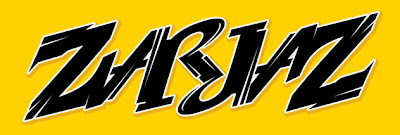
Yes, it's another one of those ambigram things. I'm really pretty chuffed about this, and for another scoop here how it's going to look on the cover of issue 08!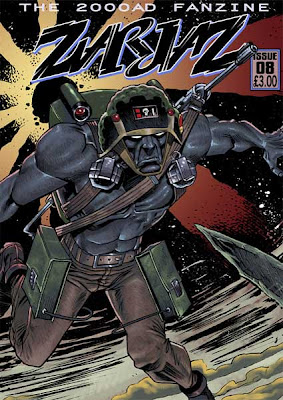
I also have a strip in this issue as previously blogged about. Copies will be ready for BICS on 3rd October and will be available there, via The Quaequam Blog or the FutureQuake shop. There will also be new issues of Dogbreath (with another strip by me) and Future Quake available too.
Awesome Rogue Trooper artwork courtesy of the ever brilliant PJHolden and Steve Denton (colours).
Gonna have to go before I start giggling like a little girl - I'm so excited!
Yesterday was the bumper 2000AD signing at Forbidden Planet in London to support the release of David Bishop's Thrill-Power Overload in paperback. I dutifully got a copy signed by the the gang of charming creators (affectionately known as 'droids') who were in attendance.
My thanks for pleasant chatettes go to: Dan Abnett, David Bishop, Simon Davis, Rufus Dayglo, Al Ewing, Henry Flint, Frazer Irving, Tony Lee, Brendan McCarthy, Matt Smith and Si Spurrier. Particular thanks to Simon in fact for looking at my work, claiming to know me from somewhere but mainly for being ego boosting about my artwork - charming fellow!
Once again I showed my work to Tharg - poor man hemmed in by my portfolio, a table and a rack of books (not to mention the other fans of the Galaxy's Greatest Comic) - I left him no where to go...
...He was once again very kind about my story telling and complimentary about certain other aspects of my work, although he didn't think I was exactly suited to Dredd, he told me to e-mail him my samples. No promise of work but a major step forward!
On friday I had managed to bash out this extra page of finished pencils.
I don't think it helped much other than I felt I had enough in my porfolio to show what I could do with a script. Look out for a subtle Police Academy reference on this page.
I'm not sure how close I am to having my work printed in 2000AD but a letter I sent in is printed in this week's prog... more on that when I pick up my copy in the week!
This was such a fun panel to attend and Chris Hardwick was hilarious! Thanks for the fantastic review Hannah!
“No longer do companies tell us what to watch”
Well, they never did. They create shows, product, whatever, and it was everyone’s choice to watch them. Just like all the upcoming product Hardwick plans to make.
I never understood how anyone could sit through “Talking Dead” right after “Walking Dead”. I suppose if you’re really into WD, then it’s fun to sit through 30 minutes of the most vapid “discussion” ever broadcast.
Nothing like seeing Chris stammer and stutter while calling Jeff Lemire and Scott Snyder the founds of Vertigo Comics. Derp. Way to let your producers put words in your mouth. Vapid is correct.
Mikael and Rich Harvey, you guys seem nice.